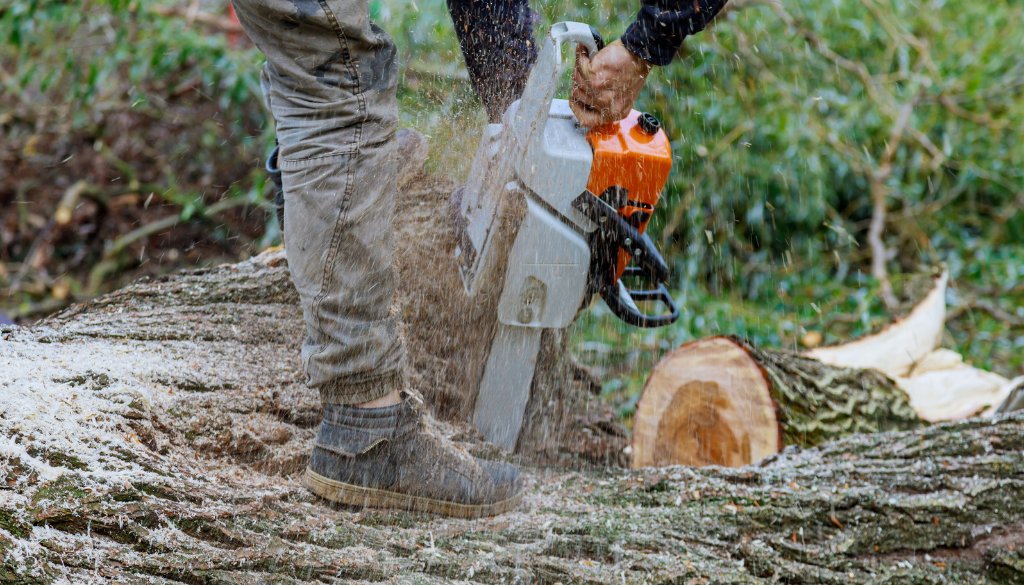If you’re here, you’re probably tired of tripping over roots in your yard, or maybe they’re cracking your sidewalk. It’s very frustrating. And it’s not always clear what you’re supposed to do about it. So let’s talk about exposed tree roots, why they show up, what they mean, and whether cutting them is a good idea.
Why Are My Tree Roots Above Ground?
Roots usually grow underground, but sometimes they push up through the surface. It’s more common than most people realize, especially in older trees. Soil erosion, compaction, shallow-rooted species, and even past landscaping work can all be part of the problem.
In many New York yards, you’ll see tree roots running right along the surface, thick, bumpy, and very much in the way. It can make mowing lawns a nightmare. It can also look bad and mess with your lawn. A lot of people ask us: Can I cut exposed tree roots to fix this?
Here’s the Short Answer
Yes – you can cut exposed tree roots. But that doesn’t mean you should.
Cutting the wrong root, or cutting too many, can seriously damage the tree. In some cases, it can kill it. We’ve seen homeowners go at roots with a saw or shovel, thinking they’re just cleaning up the yard, and six months later, the tree is showing signs of stress or rot.
So before you do anything, you need to understand what kind of roots you’re looking at and what the risks are.

Which Tree Roots Can You Cut?
Not all roots are the same. Some feed the tree. Others keep it standing upright. Cut either one in the wrong way, and you could end up with a sick tree or a dangerous one.
Here’s the general rule: if the root is large, close to the trunk, or seems to be one of the main supports, don’t touch it. That root is doing real work. If it’s thinner, smaller, or farther out near the edge of the canopy, there’s a little more room to work.
We always recommend having a certified arborist take a look. We can tell which roots are structural, which are feeder roots, and which ones you might be able to trim without causing long-term damage.
Why Are Surface Roots a Problem?
A lot of people ask how to get rid of tree roots aboveground because they’re ruining the lawn, lifting pavers, or making parts of the yard unusable. That’s fair.
Roots can:
- Crack walkways and sidewalks
- Damage foundations
- Trip kids or pets
- Kill grass around them
- Interfere with landscaping plans
If roots are damaging property, we get why you’d want them gone. But cutting exposed tree roots is usually not the first move. There are other options that are safer, and often more effective, long-term.

What Can You Do Instead?
We handle a lot of root problems around New York, and in most cases, we don’t start by cutting. Instead, we might:
1. Add Mulch Around the Base
Covering the area with a few inches of mulch can protect the roots, improve the look of the yard, and eliminate the mowing problem. It also, of course, helps the tree stay healthy.
2. Build Around the Roots
In some cases, we can work around roots instead of cutting them. Think raised beds, low walkways, or modified landscaping that gives the roots space.
3. Soil Conditioning or Aeration
If compaction is pushing roots to the surface, aerating the soil or improving drainage can make a difference.
4. Selective Root Pruning (If It’s Safe)
If we find roots that are safe to remove, we’ll prune them cleanly using the right equipment, and we’ll do it in a way that gives the tree the best chance of staying healthy.
Can Cutting Tree Roots Kill a Tree?
Yes. It happens more than people think.
Cutting roots can stress a tree and leave it vulnerable to disease. Worse, if you cut a support root, the tree may fall. We’ve seen trees that appear fine, suddenly tip in a storm because their root system was compromised months earlier.
This is why we don’t just show up and start chopping like crazy. One quick fix could cost you the whole tree.
Are Tree Roots Damaging My Lawn?
They can. Exposed roots often kill off the grass above them. The roots absorb water before the grass can, and they block sunlight from reaching the soil. You’re left with patchy spots, dry grass, and a bumpy yard.
But again, removing the roots won’t necessarily fix the lawn. It could just make things worse. If the tree goes into decline, your yard problem turns into a tree problem fast.

So, What Should You Actually Do?
Every tree and every yard is different. But here’s what we usually recommend:
- Don’t cut large or shallow roots on your own.
- Call us for a root assessment. It’s quick and gives you a clear plan.
- If roots can be pruned safely, we’ll handle it cleanly and carefully.
- If cutting isn’t an option, we’ll help you manage the issue with other tools, mulch, landscaping adjustments, or soil improvement.
It’s your property. Your yard should be safe, functional, and look the way you want it to. But healthy trees are important, too. The key is to fix the surface problem without creating a bigger one underground.
Final Thoughts
Exposed tree roots are frustrating. But if you’re thinking about how to get rid of tree roots aboveground, or wondering can I cut exposed tree roots myself – the safest bet is to slow down and talk to someone who knows what those roots are doing.
We work with homeowners across New York all the time to figure out the best approach. Sometimes it means pruning or needing professional tree removal services. Sometimes it means protecting the tree and changing the layout of the yard. Either way, it starts with a look at what’s really going on under the surface.

